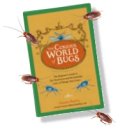 I briefly review Daniel Marlos’ latest book, Curious World of Bugs, in Six Sexy Science Books. But, I wanted to know more about the book and so offered Marlos a few questions on which he might wax lyrical.
I briefly review Daniel Marlos’ latest book, Curious World of Bugs, in Six Sexy Science Books. But, I wanted to know more about the book and so offered Marlos a few questions on which he might wax lyrical.
What makes bugs such a fascinating subject?
Bugs make such a fascinating subject because they are ubiquitous. Bugs can be found all over the world in every conceivable environment. Unlike larger animals that flee when they are being observed, bugs couldn’t care less who is watching them and they are ready subjects to be photographed. Many children have a fascination with bugs, though sadly, most adults outgrow this initial reaction to the lower beasts.
What is the most remarkable bug?
This is of course my opinion, but I find the preying mantis to be the most remarkable bug. They are large and formidable predators. There is something almost human in their gestures and they will follow their prey or a larger predator by rotating their heads nearly completely around.
What’s the biggest? And prehistorically how does it compare to those giants of the past?
I would have to question a definition of biggest. The moth with the largest wingspan at twelve inches is the South American white witch. The moth with the greatest surface wing area is the Southeast Asian atlas moth. The longest insect is probably a walkingstick from Borneo that has been recorded at 14 inches long. The insect with the greatest mass is probably the African goliath beetle but the longest beetle is a South American longhorn beetle called a titan beetle that can cover the palm of an adult man, and that doesn’t include its substantial antennae. All of these are dwarfed by a prehistoric dragonfly that has been recorded in the fossil record as having a 30 inch wingspan.
Social insects are, in a sense, meta-organisms aside from our use of bees, do you think we could somehow engineer colonies to carry out other tasks?
Other than honey bees, I don’t think humans would have much luck tapping the social insect world to perform menial labour tasks. Wasps would sting and termites might eat our wooden homes. Ants would compete for food, so it seems we are limited to apiculture when it comes to having social insects perform a service for people.
Bugs will no doubt be here long after we as a species have burned outselves out, might there be a future with “intelligent” bugs?
Depending upon how intelligence is defined, there are numerous intelligent insects. Cockroaches can be taught to run a maze. Social insects like ants, bees, wasps and termites have a highly developed caste system and the individual will sacrifice for the good of the colony. Though social insects care for their young, they are not the only bugs to do so. Many spiders will defend their eggs and hatchlings including the nursery web spiders and the green lynx spider. Many parasitic wasps like the cicada killer, the great golden digger wasp and the tarantula hawk battle and paralyze insects and spiders to provision a nest for their young. Some predatory fireflies mimic the light flashing patterns of more docile species to entrap them for prey, and certain tropical cockroach males are female impersonators that trick more dominant males into mating and while the dominant male is in a compromising position, the female impersonator bites off its competitor’s wings, virtually emasculating him.
Why do you think so many people are so repelled by bugs, despite their obvious merits?
People are often repelled by things they don’t understand, which is one of the reasons humans are often such an intolerant society.
To us Brits, a bug is a germ, a microbe that causes an illness, could that be the subject of The Curious World of Bugs 2.0?
Not a chance. I am not interested in viewing the world through a microscope. Besides, germs are better left to scientists and not artists with an interest in pop culture like me.